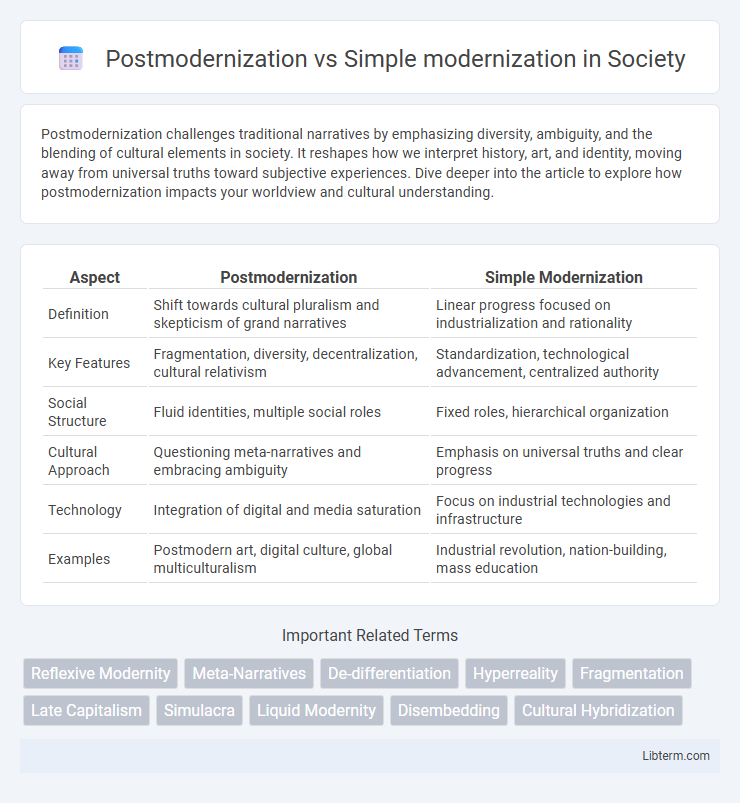Postmodernization challenges traditional narratives by emphasizing diversity, ambiguity, and the blending of cultural elements in society. It reshapes how we interpret history, art, and identity, moving away from universal truths toward subjective experiences. Dive deeper into the article to explore how postmodernization impacts your worldview and cultural understanding.
Table of Comparison
| Aspect | Postmodernization | Simple Modernization |
|---|---|---|
| Definition | Shift towards cultural pluralism and skepticism of grand narratives | Linear progress focused on industrialization and rationality |
| Key Features | Fragmentation, diversity, decentralization, cultural relativism | Standardization, technological advancement, centralized authority |
| Social Structure | Fluid identities, multiple social roles | Fixed roles, hierarchical organization |
| Cultural Approach | Questioning meta-narratives and embracing ambiguity | Emphasis on universal truths and clear progress |
| Technology | Integration of digital and media saturation | Focus on industrial technologies and infrastructure |
| Examples | Postmodern art, digital culture, global multiculturalism | Industrial revolution, nation-building, mass education |
Understanding Modernization: A Brief Overview
Postmodernization challenges the linear progression implied in simple modernization, emphasizing cultural diversity, social complexity, and the fragmentation of traditional identities. Simple modernization focuses on industrial growth, technological advancement, and institutional development as markers of progress. Understanding modernization requires analyzing these contrasting perspectives to capture the multifaceted nature of societal change in contemporary contexts.
Defining Postmodernization: Key Characteristics
Postmodernization is characterized by a shift from traditional industrial economies to knowledge-based societies emphasizing cultural diversity, individualism, and skepticism toward grand narratives. Unlike simple modernization, which prioritizes economic growth and technological progress, postmodernization focuses on social complexity, reflexivity, and the deconstruction of established norms. Key traits include increased pluralism, emphasis on symbolic meanings, and a transition toward post-industrial values in areas such as politics, culture, and identity.
Historical Evolution: From Modern to Postmodern
Postmodernization emerged as a critical response to the limitations of simple modernization, emphasizing cultural pluralism, decentralization, and skepticism toward grand narratives that characterized the modern era. While simple modernization focused on industrialization, urbanization, and rational progress primarily driven by economic and technological advancements from the 18th to mid-20th centuries, postmodernization arose in the late 20th century highlighting diverse identities, deconstruction of universal truths, and reflexivity. This historical evolution reflects a shift from the uniformity and linear development models of modernity to a fragmented, multifaceted understanding of social, cultural, and political changes in contemporary societies.
Core Differences Between Modernization and Postmodernization
Modernization centers on industrial growth, technological advancement, and rational societal structures aimed at uniform progress and economic development. Postmodernization challenges these narratives by emphasizing cultural diversity, skepticism toward grand narratives, and the decentralization of authority in social and political realms. Core differences include modernization's focus on universal truths and linear progress, whereas postmodernization embraces pluralism, local identities, and the questioning of objective knowledge.
Technological Transformations in Modern and Postmodern Eras
Technological transformations in the modern era emphasize industrialization, mass production, and mechanization, driving economic growth and societal change through innovations like the steam engine and electricity. Postmodernization shifts focus to digital technology, information systems, and network connectivity, fostering decentralized knowledge dissemination and cultural pluralism through developments such as the internet and artificial intelligence. This transition highlights a move from uniform technological paradigms to diverse, flexible, and interactive digital environments shaping contemporary social and economic structures.
Socio-Cultural Shifts: Changing Values and Norms
Postmodernization emphasizes the fragmentation of traditional social structures and the rise of individualism, challenging established values and norms through pluralism and relativism. Simple modernization generally assumes a linear progression toward rationality, secularism, and homogenized cultural values, promoting stability and consensus within society. Shifts in postmodern societies include growing skepticism toward grand narratives and increased acceptance of diverse identities, contrasting with the uniform cultural adaptation seen in simple modernization processes.
Economic Development: Modernization vs Postmodernization
Economic development in modernization emphasizes industrialization, urbanization, and technological innovation as pathways to progress and increased productivity. Postmodernization challenges these linear models by prioritizing sustainability, cultural diversity, and decentralized economic structures, reflecting shifts in global economic practices. Both frameworks influence policy-making, with modernization focusing on growth metrics and postmodernization integrating social equity and ecological balance into economic strategies.
Impacts on Identity and Individualism
Postmodernization challenges the fixed identities and collective narratives emphasized in simple modernization by promoting fluid, fragmented, and pluralistic self-conceptions that reflect diverse cultural influences. Simple modernization typically fosters a unified sense of identity through industrialization, urbanization, and rationalization, encouraging individuals to align with broader societal roles and norms. The shift toward postmodernization amplifies individualism by validating personal expression and subjective experiences, leading to increased identity exploration and the erosion of traditional social structures.
Critiques and Controversies Surrounding Both Paradigms
Postmodernization faces critiques for its rejection of grand narratives and skepticism towards objective truths, which some argue leads to relativism and undermines social progress. Simple modernization is criticized for its linear, Eurocentric development model that often overlooks cultural diversity and exacerbates inequalities. Both paradigms spark controversies regarding their efficacy in addressing global challenges, with debates centered on whether rigid structures or fragmented perspectives better foster sustainable development.
Future Trajectories: Modern, Postmodern, or Beyond?
Future trajectories in modernization reveal divergent paths: simple modernization emphasizes technological advancement and economic growth within established frameworks, while postmodernization stresses cultural pluralism, decentralization, and skepticism of grand narratives. Emerging trends suggest a hybrid approach that integrates digital innovation with postmodern values such as diversity and sustainability, potentially leading to a new paradigm beyond traditional modernization models. Research indicates societies increasingly adopt flexible, adaptive strategies that transcend linear progress, reflecting complexities of global interconnectivity and evolving social dynamics.
Postmodernization Infographic

 libterm.com
libterm.com